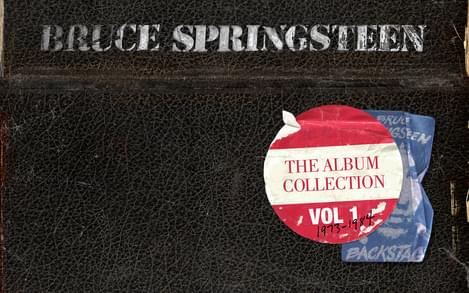Bruce Springsteen - The Album Collection Vol. 1: 1973-1984
"The Album Collection Vol. 1 1973-1984"

The main draw for E Street fans here is the fact only Born To Run and Darkness On The Edge Of Town have previously been re-mastered. Although this collection does include contemporary E Street ephemera in the form of a 60-page book, there’s no additional previously unreleased music to supplement these albums, but given they’re some of popular music’s all-time finest, that’s not too much of a setback.
Debut Greetings From Asbury Park, N.J. (1973) has the feel of a rough Springsteen first draft, a bunch of obfuscatory Jersey Shore sketches unveiled just a few months after Springsteen has signed to Columbia Records. “Mary Queen of Arkansas” may be a little self-conscious and strained, but “Growin’ Up” hints at street-poet grandeur yet to come.
The prompt follow-up was his stepping-stone to immortality: The Wild, The Innocent and The E Street Shuffle (1973.) A markedly looser LP, it broadens the band’s scope by combining a jazz rock influence with a carefree pop slant. Still featuring the formative E Street line-up including keyboard player David Sancious and drummer Vini Lopez, a nostalgic depiction of a crumbling “south beach drag” in “4th of July, Asbury Park (Sandy)” is infused with an understated yet powerful melancholy, augmented by the late Danny Fedirici’s lugubrious accordion. The penultimate track “Rosalita (Come Out Tonight)” has long served as the traditional showstopper at E Street concerts, and it remains an utter joy - a sly, rollicking, insubordinate blast of lusty youthful brio, propelled by an ebullient contribution from another fallen E Street stalwart, saxophonist Clarence Clemons.
The career-defining Born To Run (1975) came next, bringing the Wall of Sound-informed highway escapist fantasies and bestowing upon a reluctant Bruce a “Saviour of Rock 'n' Roll” tag. There’s really little more to add to any discussion regarding the superlative merits of “Thunder Road”, “Backstreets” and “Jungleland”, but listening to the Springsteen back catalogue in chronological order, its BTR’s shortest and possibly bleakest tune, “Meeting Across The River”, that clearly provides the genesis of much of what is to follow.
As Bruce approached thirty and the youthful vigour diminished, Darkness On The Edge Of Town (1978) served as a bitter reality check that still packs a tremendous anthemic clout, most powerfully on “Badlands” and “The Promised Land.” But those once-brazen all-night shoreline romantic trysts are now depressingly furtive, as depicted in “Candy’s Room.” The unfulfilled Jersey Shore boy-racer protagonists of “Racing In The Street” want nothing more than to merely survive, and even if you do stick around, as “Factory” suggests, a stultifying existence alongside “men with death in their eyes” is all that awaits. “If dreams came true, oh, wouldn't that be nice?” Springsteen ponders on “Prove It All Night”, scoffing at the hopelessly naive idealism of his younger self.
1980’s The River is a mixed-bag double album in which sentimental weepies vie with good time party tunes (the title track’s gloomy account of stifled potential amidst economic uncertainties feels particularly jarring after a run of cheerier numbers) as well as a big hit single in the form of “Hungry Heart.” Guitarist Steve van Zandt’s Rickenbacker-style jangle shines through on the cleaned-up version of opener “The Ties That Bind”, a song that kicks off a mostly pretty chipper side one – even the prospect of driving his mother-in-law to the unemployment office can’t bring Bruce down on “Sherry Darling.” Bruce has rarely sounded more fun than he does on “Cadillac Ranch” and “Ramrod”, but evocative closer “Wreck On The Highway” leads in thematically to the next album: the entirely sombre, serious-minded Nebraska (1982.)
This is a record where murder, mayhem and minimalism collide, with Bruce armed with little more than an acoustic guitar, a harmonica and a 4-track. A lo-fi examination of the US underbelly via its long-standing folk traditions and some brisk rockabilly, Nebraska revolves around the stories of desperate, despairing characters, often ending in some violent denouement. These individuals may be broken and on a last chance power drive, but they’re certainly far from heroes.
A few years ago, a mysterious but savvy pop commentator called The Passionate and Objective Jokerfan released a track entitled “Bruce Springsteen's Nebraska”, and pretty much nailed the muted intimacy of these recordings: “Somehow when you listen to Nebraska, you feel like you’re a guest in Bruce Springsteen’s living room, and he’s playing these songs for you.” Ideologically, it’s an album somewhat at odds with itself– the condemned young killer in the nihilistic title track concludes that there’s “just meanness in this world”, but light-at-the-end-of-the-tunnel climax “Reason To Believe” seems to offer at least a glimmer of hope.
Finally, Born In The U.S.A. (1984) was the all-conquering, hit-supplying automaton that pushed Springsteen into mega-stardom. The name of the album alone invokes an immediate mental flip chart - popularly misconstrued title track, iconic sleeve photo by Annie Leibovitz, Courtney Cox dancing on stage with Bruce in the “Dancing In The Dark” promo, seemingly interminable run of stellar hit singles – that it’s easy to forget just how much light and shade dwells within BITU. Lyrically, the conflict between blue-collar pains and pleasures remain central, but amongst the arena-ready sing-alongs and the raucous bar romps are considered reflections on friendship and family life as Springsteen moved into his mid thirties. One of the all-time great side twos in rock also features “I’m on Fire”, perhaps Bruce’s sexiest moment, as well as his most defiant, “No Surrender.”
The immediately subsequent era would find Bruce contend with divorce, parenthood and the dissolution of the E Street Band, in addition to thirty more years (and counting) of recording and touring. There were fascinating chapters aplenty still to be written, but this is surely one of the ultimate “early phases” in twentieth century popular culture.
Get the Best Fit take on the week in music direct to your inbox every Friday

Lorde
Virgin

OSKA
Refined Believer

Tropical F*ck Storm
Fairyland Codex





